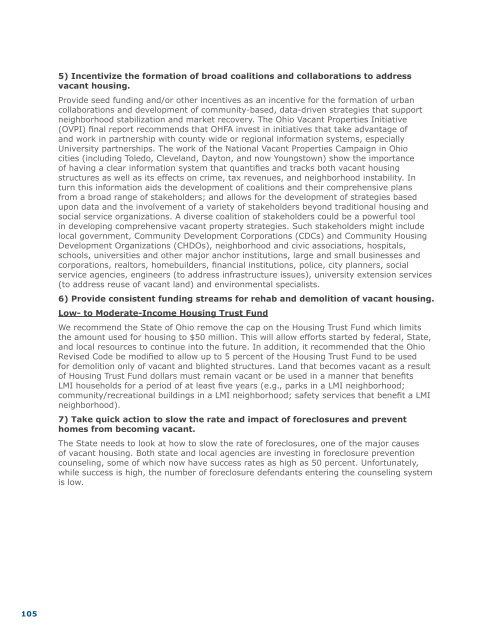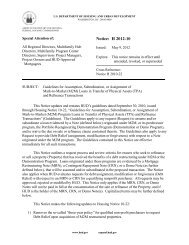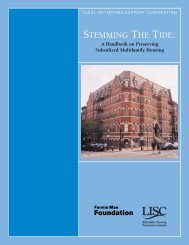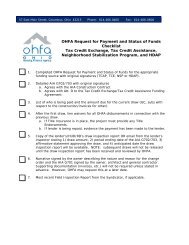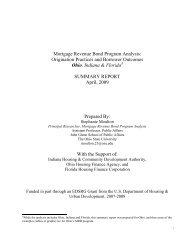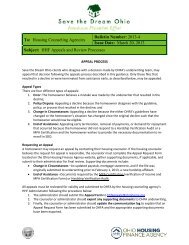OHFA Annual Plan - Ohio Housing Finance Agency
OHFA Annual Plan - Ohio Housing Finance Agency
OHFA Annual Plan - Ohio Housing Finance Agency
You also want an ePaper? Increase the reach of your titles
YUMPU automatically turns print PDFs into web optimized ePapers that Google loves.
5) Incentivize the formation of broad coalitions and collaborations to addressvacant housing.Provide seed funding and/or other incentives as an incentive for the formation of urbancollaborations and development of community-based, data-driven strategies that supportneighborhood stabilization and market recovery. The <strong>Ohio</strong> Vacant Properties Initiative(OVPI) final report recommends that <strong>OHFA</strong> invest in initiatives that take advantage ofand work in partnership with county wide or regional information systems, especiallyUniversity partnerships. The work of the National Vacant Properties Campaign in <strong>Ohio</strong>cities (including Toledo, Cleveland, Dayton, and now Youngstown) show the importanceof having a clear information system that quantifies and tracks both vacant housingstructures as well as its effects on crime, tax revenues, and neighborhood instability. Inturn this information aids the development of coalitions and their comprehensive plansfrom a broad range of stakeholders; and allows for the development of strategies basedupon data and the involvement of a variety of stakeholders beyond traditional housing andsocial service organizations. A diverse coalition of stakeholders could be a powerful toolin developing comprehensive vacant property strategies. Such stakeholders might includelocal government, Community Development Corporations (CDCs) and Community <strong>Housing</strong>Development Organizations (CHDOs), neighborhood and civic associations, hospitals,schools, universities and other major anchor institutions, large and small businesses andcorporations, realtors, homebuilders, financial institutions, police, city planners, socialservice agencies, engineers (to address infrastructure issues), university extension services(to address reuse of vacant land) and environmental specialists.6) Provide consistent funding streams for rehab and demolition of vacant housing.Low- to Moderate-Income <strong>Housing</strong> Trust FundWe recommend the State of <strong>Ohio</strong> remove the cap on the <strong>Housing</strong> Trust Fund which limitsthe amount used for housing to $50 million. This will allow efforts started by federal, State,and local resources to continue into the future. In addition, it recommended that the <strong>Ohio</strong>Revised Code be modified to allow up to 5 percent of the <strong>Housing</strong> Trust Fund to be usedfor demolition only of vacant and blighted structures. Land that becomes vacant as a resultof <strong>Housing</strong> Trust Fund dollars must remain vacant or be used in a manner that benefitsLMI households for a period of at least five years (e.g., parks in a LMI neighborhood;community/recreational buildings in a LMI neighborhood; safety services that benefit a LMIneighborhood).7) Take quick action to slow the rate and impact of foreclosures and preventhomes from becoming vacant.The State needs to look at how to slow the rate of foreclosures, one of the major causesof vacant housing. Both state and local agencies are investing in foreclosure preventioncounseling, some of which now have success rates as high as 50 percent. Unfortunately,while success is high, the number of foreclosure defendants entering the counseling systemis low.105


